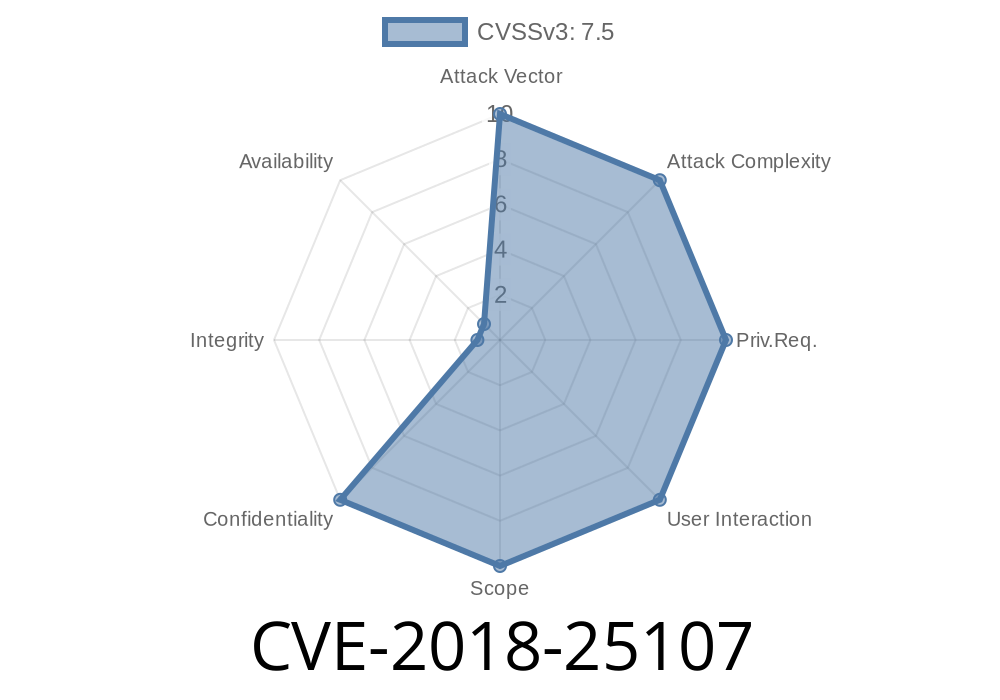When building secure applications, especially those dealing with cryptography, generating truly random numbers is a cornerstone for safety. Sadly, even a slight mistake in this area can fatally weaken security. One such serious mistake existed in the Crypt::Random::Source Perl module before version .13, tracked as CVE-2018-25107.
In this post, I’ll walk you through what went wrong, how the vulnerability works, why it’s extremely dangerous, and how to check and fix it. Plus, I’ll include code snippets and original references.
What Is CVE-2018-25107?
CVE-2018-25107 pinpoints a flaw in the way the Crypt::Random::Source package for Perl generates random data. Before version .13, if the module couldn't find a reliable randomness source, it would fall back to Perl’s built-in rand() function, which isn’t meant for cryptographic purposes and is predictable.
> Simply put: Systems using this module could have cryptography that is easy to break, because attackers can guess or reproduce the “random” values.
Why is rand() Unsafe?
Perl’s rand() is a pseudo-random number generator (PRNG) designed for simple randomness, such as picking a random winner in a game, not for secure key creation or cryptographic tokens. If a key or token can be guessed by an attacker, all bets are off – your secrets aren’t secret anymore.
Here’s a trimmed example from older versions of Crypt::Random::Source (before .13)
# Simplified logic demonstrating fallback
my $data;
# Try to use /dev/urandom (or other strong sources)
if (!open(URANDOM, "/dev/urandom")) {
# If that fails, fallback!
$data = join '', map { chr(int(rand(256))) } 1 .. $bytes_needed;
}
If the preferred random source (like /dev/urandom on Unix) isn’t available (for example, on Windows or in a restricted environment), the library just gives up and switches to this Perl rand()-based sequence.
The problem?
If you use this random output for keys, tokens, salts, or nonces, an attacker can predict or brute-force them. Any cryptographic process relying on this randomness is easily broken.
Exploiting This Vulnerability
Let’s assume you’ve built a web service that uses Perl’s Crypt::Random::Source to create password reset tokens:
# Hypothetical vulnerable code
use Crypt::Random::Source;
my $generator = Crypt::Random::Source->new;
my $token = unpack('H*', $generator->get_bytes(16));
Scenario:
On a misconfigured server, /dev/urandom isn’t accessible, so the module uses rand(). If an attacker gets a few tokens, or can guess the seed (often based on time or process ID), they might be able to reconstruct future tokens or brute-force them fast.
If you generate secret keys this way
my $key = $generator->get_bytes(32);
Attackers can guess, brute-force, or recreate your key space.
Real-World Example
Suppose your web app generates Time-based One-Time Passwords (TOTP) secret seeds using this random source. A predictable seed = an attacker's dream.
Your platform has no access to strong random sources.
- You use this module for any cryptographically significant randomness: passwords, keys, tokens, nonces, salts, etc.
Upgrade Crypt::Random::Source to at least version .13.
The fixed version will *not* fallback to Perl’s weak rand() function, and will instead fail loudly if no secure source is present.
Verify your environment supports secure randomness.
- On Unix, the presence of /dev/urandom or /dev/random.
On Windows, ensure CryptGenRandom or a secure API is available.
3. Review your code: Ensure you do not have any fallback to rand() or other weak sources in *any* custom security touches.
Code Snippet: Checking For Insecure Fallback
Here’s a simple way to check if your Perl code is affected, scan for direct or indirect use of rand() during cryptographic data creation:
# Search in your codebase for these patterns
grep -r "rand(" .
grep -r "Crypt::Random::Source" .
If you find they're used together, and Crypt::Random::Source is <.13, you are at risk.
Extra Reading & References
- CVE Source at MITRE
- Crypt::Random::Source Release Notes (.13)
- OWASP: Using Cryptographically Secure PRNGs
- Exploiting Predictable Random Values
Conclusion
CVE-2018-25107 is a clear reminder that even very small libraries can introduce subtle but disastrous vulnerabilities – especially in cryptography. If you’re using Crypt::Random::Source in Perl, make sure to upgrade immediately, and always check your random number sources are cryptographically secure. Never trust simple PRNGs for key or token generation!
Stay secure: update, audit, and test your random sources.
*Let me know if you need more help securing your Perl stack or want to discuss advanced random number safety!*
Timeline
Published on: 12/29/2024 07:15:05 UTC
Last modified on: 12/31/2024 19:15:07 UTC
